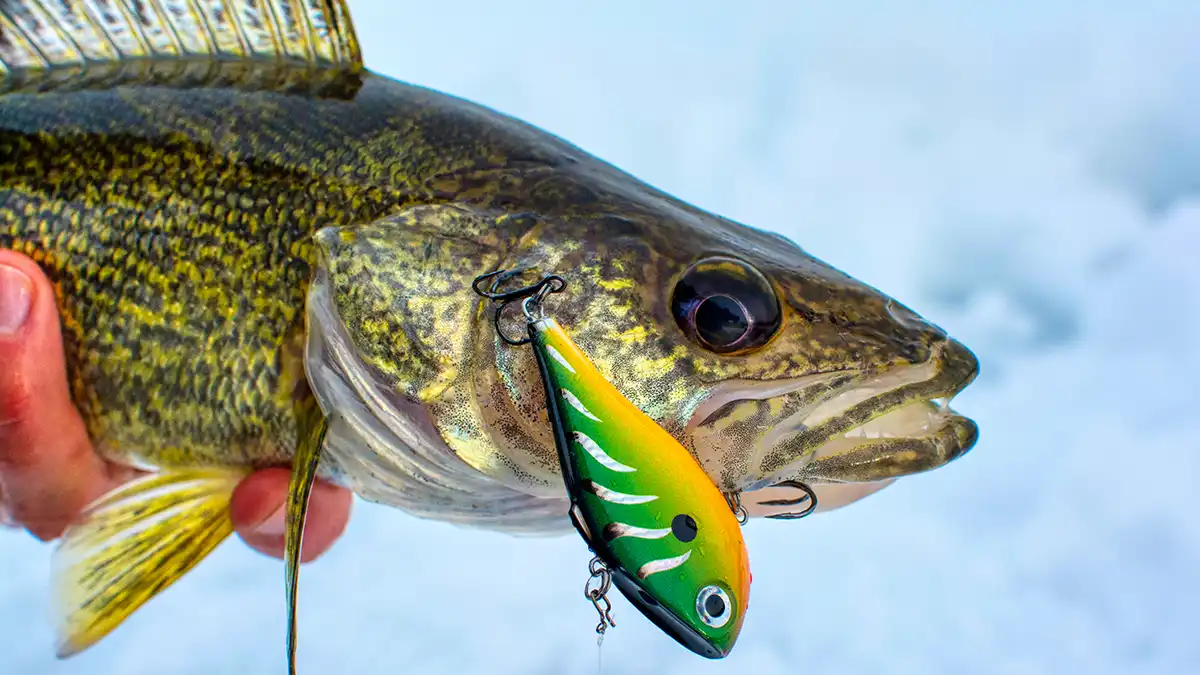Warning: Undefined variable $k in /home/nginx/domains/wired2fishcom.bigscoots-staging.com/public/wp-content/themes/understrap-child-0.6.0/functions.php on line 984
Warning: Undefined variable $k in /home/nginx/domains/wired2fishcom.bigscoots-staging.com/public/wp-content/themes/understrap-child-0.6.0/functions.php on line 987
Wondering what gear and equipment you need for ice fishing? In this article, we cover all the essential ice fishing equipment you’ll want to get started catching walleye, northern pike, trout, crappie, yellow perch, bluegill and more. In addition to listing gear, we also shares plenty of tips to help you become a more efficient and successful ice angler.
An angler needs to consider the following when gathering gear for ice fishing:
- Dressing for ice fishing
- Ice fishing augers and accessories
- Jigging set-ups for ice fishing
- Tip-ups and rattle reels
- Lures, jigs and terminal tackle for ice fishing
- Gear and tackle storage
- Ice sleds and portable fish houses (aka ice fishing shelters)
- Fish finders and underwater cameras
- Tools and other handy items
- Safety gear for ice fishing
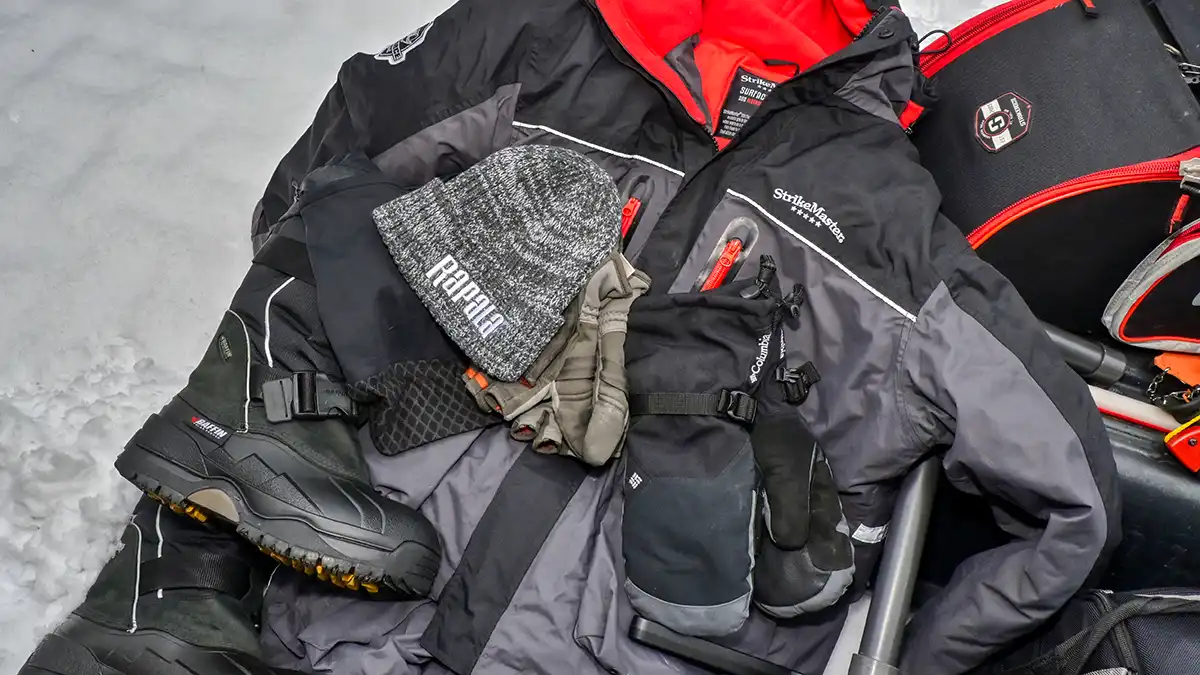
Clothing
Ice fishing isn’t fun when you’re cold, which is why wearing quality thermal apparel and outerwear is critical. Things go from bad to worse when discomfort invites more serious risks, such as frost bite and hypothermia. We consider clothing to be the most critical ice fishing gear.
Being a lean guy with a tendency to get chilled easily, I’ve found the best way to stay comfortable ice fishing is dressing in layers, which requires owning assorted apparel for different weather and fishing scenarios. Here are some essentials from my collection.
Base and Mid-Layers
Light and mid-weight thermal tops and bottoms made of moisture-wicking polyester and merino wool work well for a base layer. Next comes more insulating clothing. Good mid-layer choices are fleece-lined pants, mid- and heavy-weight long sleeve shirts, fleece hoodies and a vest with synthetic insulation.
Merino wool hunting and hiking socks are a solid choice for keeping feet warm. High cut, over-the-calf style are less apt to fall down over the course of the day and get bunched around your toes. If unimpressed with your current sock stockpile, check out Darn Tough Vermont.
Outerwear
New ice anglers can get by with a warm winter jacket and insulated pants, outerwear made specifically for ice fishing offers many advantages. Several products provide floatation, an important safety feature. Ice fishing suits are also incredibly warm, windproof, water repellant and comfortable. Jacket and bib pants come packed with features, such as lots of pockets, big hoods and high jacket collars, plus padded knees and seats.
Striker, Clam, Eskimo, Simms, and Vexilar all make ice fishing outerwear.
A puff jacket is another handy item and I’ve used many over the years, StrikeMaster’s Light Puff Coat the most recent addition. In mild winter weather, when actively moving around and when fishing inside a shelter, a puff jacket with insulated bibs makes a great outerwear combination, which you’ll see several of the Wired2Fish team wearing in many ice fishing videos.
Warm boots are another essential. A pair of Baffin Impact pac-style boots haven’t let me down for over a decade. When it’s not bitterly cold and a lot of walking is on the agenda, I wear insulated, waterproof hunting boots. Insulated rubber boots are must-haves for slushy and mild late-ice conditions.
Rounding out outerwear are balaclavas, neck warmers and wind-proof winter hats. Don’t forget sunglasses for sun and wind protection for your eyes.
Gloves and mitts in varying degrees of insulation are critical. When temperatures allow, I like the versatility of flip mitts and have had good experiences with Simms and Glacier Glove.
Tip: Always have spare sets of gloves and mitts, and tuck a pair inside your jacket to keep them warm.
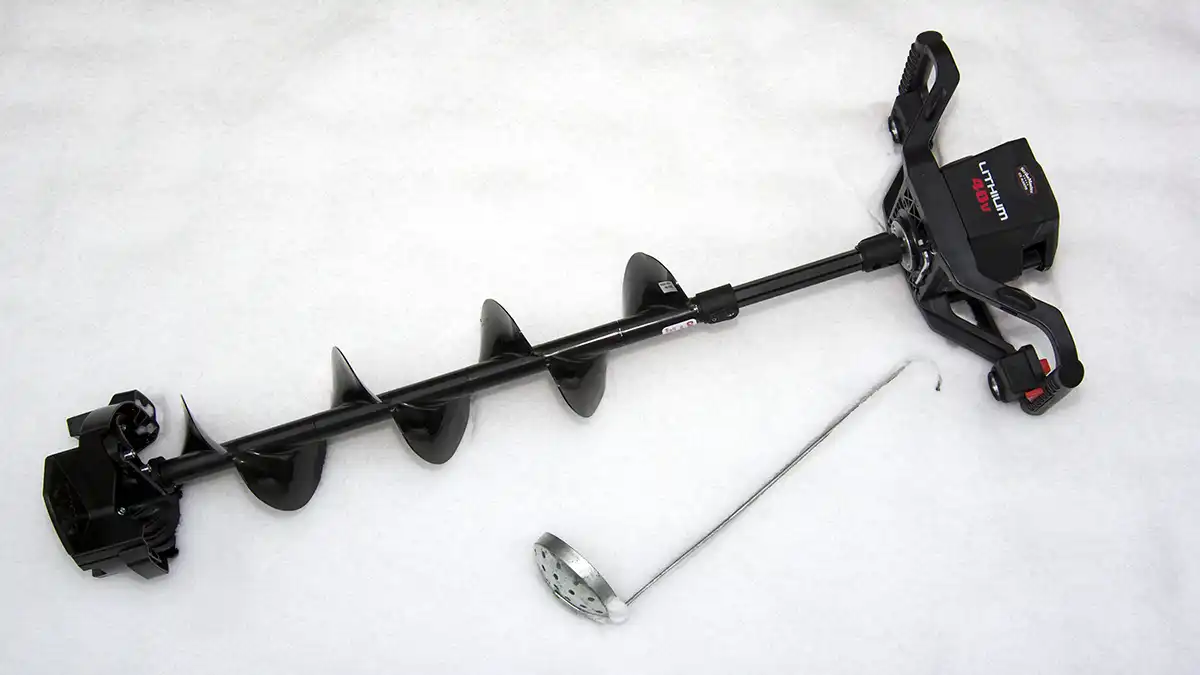
Ice Augers and Accessories
An ice drill is an essential. Yes, you can chip a hole in the ice using a spud bar, but an ice auger is the best tool for cutting multiple holes as efficiently as possible. Some auger brands to consider are StrikeMaster, Eskimo, Jiffy, Ion, Mora, Nils USA, and Razr.
Hand augers are quiet, light and affordable, but require muscle power. The thicker the ice and the wider the drill’s diameter, the more effort is required. This is partly why 4.5 to 6 inch hand drills are popular.
Power ice drills are heavier and more expensive but do the work for you. They’re a requirement for efficient run-and-gun tactics, thick ice conditions and when 10 inch holes are needed for landing big predators.
These augers come in gas, propane and electric power configurations. Another noteworthy option is using a Milwaukee M18 18V Brushless Hammer Drill Driver to power a drill unit.
Wired2Fish’s Ryan DeChaine explains a few reasons why electric augers are popular in the following video.
An ice scoop is a must for clearing slush and ice from holes. Get a metal or heavy-duty plastic model if you don’t like baby gear. A scoop with a ruler on its handle is useful for measuring ice thickness, which is an important safety practice.
Tip: Ice drill blades are extremely sharp! Always keep them covered with a blade guard when not drilling holes.
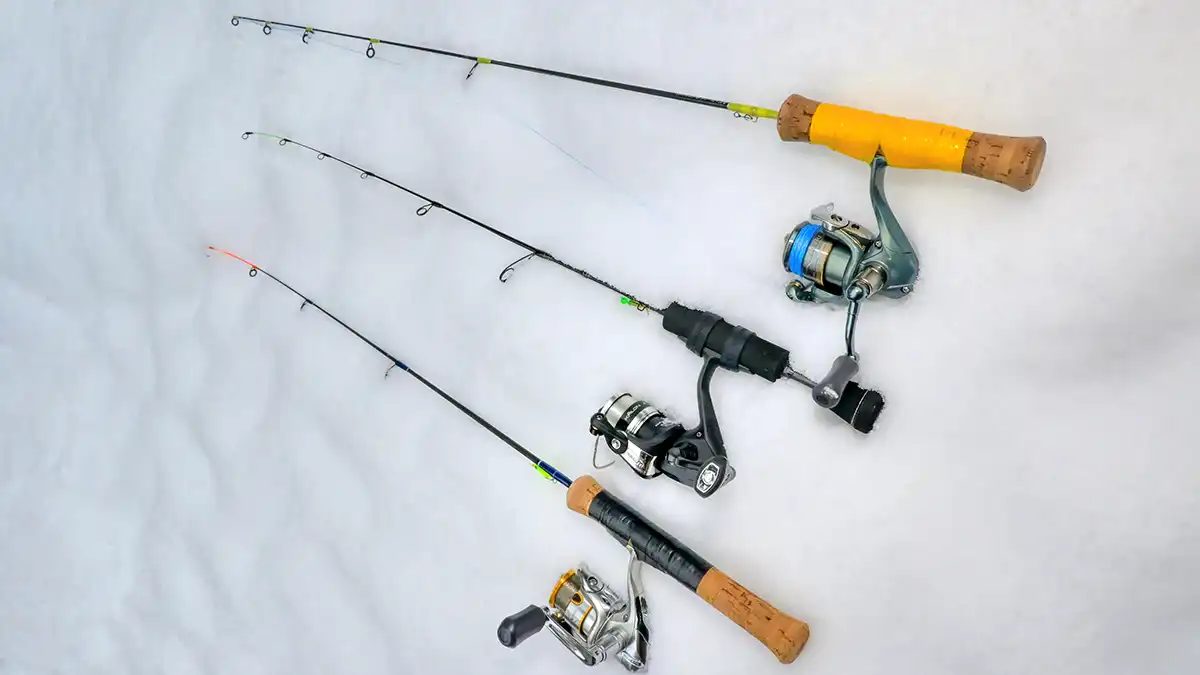
Ice Fishing Rod and Reel Jigging Set-Ups
In many ways, ice fishing rods are shorter versions of open-water models, and come in a myriad of lengths, powers, grips and material configurations. To help you find the best ice fishing rod for your needs, the following chart overviews some rod and line combinations for targeting popular fish species using different techniques, but nothing’s carved in stone, of course. Individual preferences and variances in rod characteristics across brands are other factors, meaning one brand’s light power might be closer to another’s medium-light. Lure weight capability will also vary across power classifications, depending on brand, model, length, graphite versus fiberglass blanks and so on.
Abu Garcia, 13 Fishing, Clam, Elliott Rods, G. Loomis, HT Enterprises, Thorne Bros., Tuned Up Custom Rods, Shimano and St. Croix all make ice rods.
Reviewing the chart, you likely noticed the wide range of rod lengths available. Longer rods have become increasingly popular. A longer rod means less line is exposed when jigging outside and it smooths out power transfer on hook-sets and increases cushioning when playing fish, among other benefits.
Shorter rods also have their place. These are preferred for tight-lining tactics (i.e., jigging close to a hole and line watching) and when jigging in confined ice houses. They can also be a bit more manageable for kids and easier for beginners to experience success when learning the micro jigging moves required to finesse bites.
Specialty Ice Rods
In addition to universal-type rods, there’s an abundance of technique- and species-specific ice rods. The growth of these niche rods is testament to ice fishing’s popularity combined with the increasing sophistication of today’s modern ice angler.
These rods are worth considering if you’re fond of fishing certain species using specific techniques, such as getting a dead-stick rod for soaking live minnows for walleye.
Related to the above, the benefits of owning a panfish rod with a visual strike indicator cannot be overstated when up against fussy, light biters. Whether a noodle rod with an ultra-sensitive tip or a rod with a spring bobber, the mechanics are the same. The tip (or spring) will bend slightly under the weight of the bait. When a fish bites, the indicator either drops further or straightens, signalling even the faintest of strikes.
Tony Roach talks panfish ice fishing rods in this video.
Tip: It’s good to have at least two rod combos rigged with different baits when ice fishing in order to quickly change presentations if a fish rejects the first one.
|
Power Designation |
Length in inches |
Applications and Species |
Line lbs |
|
Ultralight (UL) |
24 – 32 |
Finesse panfish presentations with lead and light tungsten ice jigs with plastics or live-bait. |
1 to 3 fluoro/mono |
|
Light (L) |
26 – 36 |
Tungsten and lead ice jigs with plastics or live-bait, as well as small lures up to around 1/8 to 3/16 ounces for panfish and certain finesse walleye scenarios. |
3 to 4 fluoro/mono |
|
Medium Light (ML) |
26 – 36 |
Spoons, lipless crankbaits, Jigging Raps, other lures and jigs around 1/8 to 1/4 ounces. A solid choice for lighter walleye and whitefish offerings. Also suitable for upsized presentations when chasing jumbo perch and slab crappie. |
4 to 6 fluoro/mono |
|
Medium (M) |
28 – 38 |
Jigging spoons, lipless crankbaits, Jigging Raps, other presentations up to around 3/8 ounces. A versatile multi-species option for walleye, whitefish, trout, eelpout and small to medium-sized pike. |
6 to 8 fluoro/mono, or 8 – 10 braid |
|
Medium Heavy (MH) |
32 – 44 |
Spoons, lipless crankbaits, Jigging Raps, other lures and jigs topping out around 1/2 to 3/4 ounces. An essential tool for taming lake trout, pike, eelpout and trophy-sized walleye. |
8 to 12 fluoro/mono or 15 to 20 braid |
|
Heavy (H) |
40 – 48 |
Made for jigging sizeable baits up to an ounce with blanks delivering plenty of power and shock absorption needed to tame big freshwater predators. |
20 to 40 braid |
Reels for Ice Fishing
Spinning reels are a popular choice for many anglers. These reels are dependable, readily available and well suited for handling light line.
Over the last decade, the availability of quality inline reels made specifically for ice fishing has increased. The latest generation inlines offer higher gear ratios and many line management features. A big selling point is inlines don’t create line twist when retrieving line.
Some anglers prefer bait casting reels for big predators. Hence, the availability of medium-heavy or heavy casting rods for ice fishing.
Locking reel seats aren’t standard on ice rods. Electrical tape is one option for securing a reel to an ice rod. Other options are specialty reel tape or reel wraps (i.e., bands) specifically for this purpose from 13 Fishing, Clam and Cold Snap.
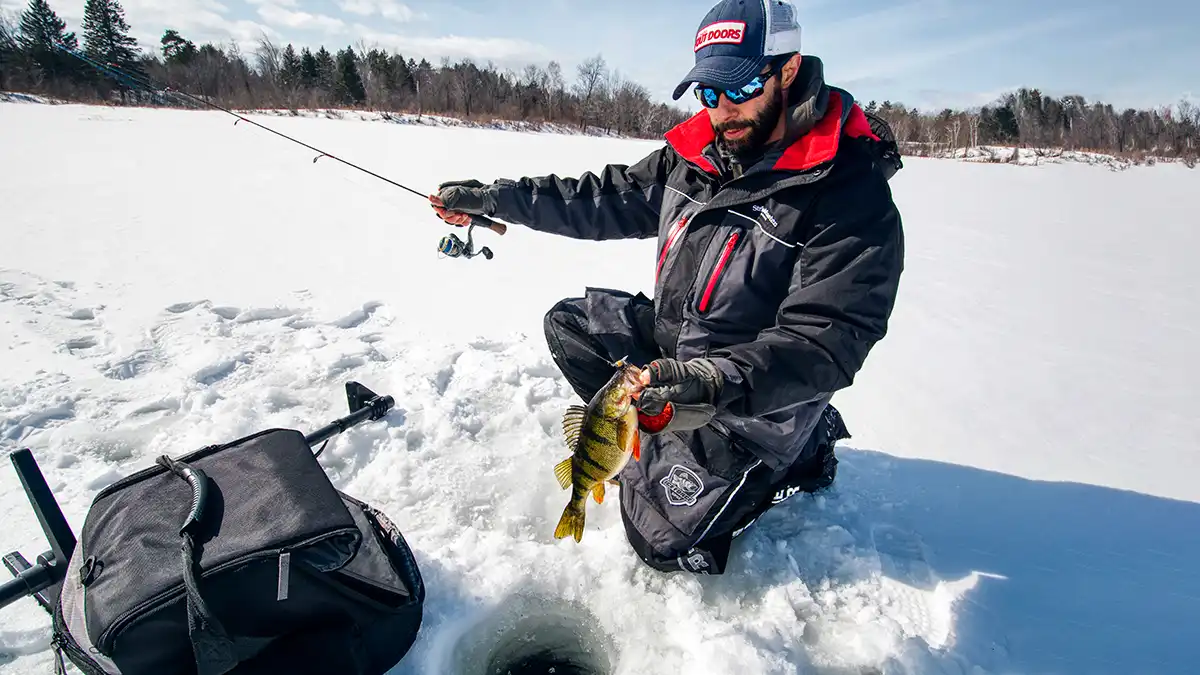
Ice Fishing Line
It’s ideal to use line specifically made for ice fishing, which ensures optimal cold-weather performance. Here are some advantages of the different lines available.
Fluorocarbon is abrasion resistant, nearly invisible underwater, sinks and has low memory. Fluoro sheds water, which limits ice build-up. A popular choice for panfish, walleye, whitefish and small trout.
Professional fishing guide Brad Hawthorne explains fluorocarbon’s benefits in this video.
A quality ice fishing monofilament or copolymer line handles well, ties knots easily and will have water-repellant protection to lessen ice build-up. Mono has more stretch and sinks slower than fluoro — these qualities may or may not be drawbacks depending on the scenario. It’s a good line choice for beginners. Last season 3-pound Sufix Advance Ice Monofilament, which has less stretch than a traditional mono, performed great on the 23 inch ultra-light 13 Fishing TickleSticks I bought my kids for panfish.
Braid’s no-stretch and thin diameter characteristics are reasons many anglers prefer it when jigging deep or targeting big predators. Ice fishing braids have hydrophobic coatings, but expect ice-up over time when jigging outside in freezing temperatures. This isn’t enough to deter professional fisherman Jeff Gustafson, who uses PowerPro braid tied to a fluorocarbon leader to catch trophy lake trout and pike in Northwestern Ontario’s Sunset Country Region.
“I want to feel what my bait is doing and get a good hook set in deeper water,” Gustafson said. “It’s superior in my opinion. If it’s super cold, I’m fishing in a portable anyways.”
There are also ice lines specifically for tip-ups and rattle reels. These thicker lines are more finger-friendly in 15- to 40-pound strengths when hand-playing fish. Vinyl and PVC coated lines won’t absorb water.
Tip: Don’t forget monofilament and fluorocarbon leader material for adding at the end of braid and for rigging set-lines.
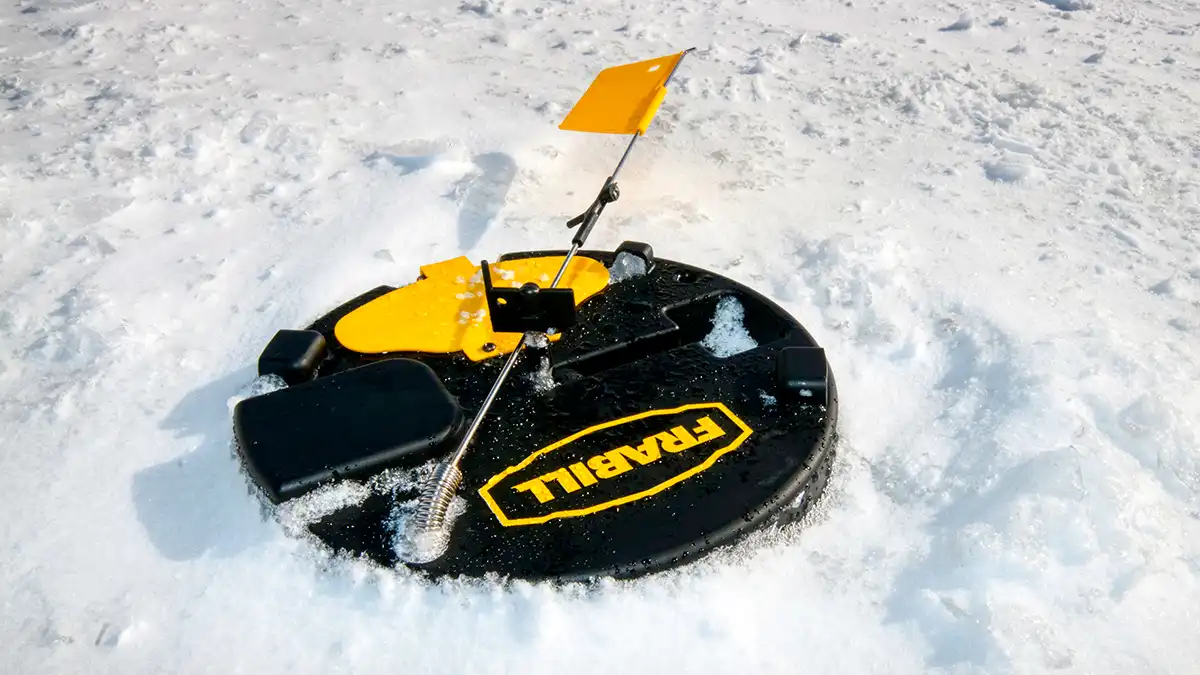
Tip-Ups and Rattle Reels
Tip-ups are standalone devices made to fit over an ice hole. Outfitted with a spool, trip mechanism and a flag as a signaling device, tip-ups are used for live minnow presentations as well as for dead-bait on quick-strike rigs for northern pike. When the flag flies, get over to the hole, grab the line, set the hook and bring in the line hand-over-hand to land the fish. Fun times!
Circular, thermal tip-ups are a popular choice. These products block snow and light from entering an ice hole, have insulation to delay freeze-over and stack neatly in a 5-gallon bucket. Products like Clam’s Arctic Warrior Tip-Up and I Fish Pro 2.0 Tip-Up are designed to work in conjunction with a rod combo.
Wired2Fish’s Kyle Peterson shares more info in this Tip-Ups 101 video.
Rattle reels are seeing a resurgence in popularity. These compact devices feature tension adjustable spools, which make noise when a walleye or other fish takes the bait and pulls line. Rattle reels are a simple but effective set-line option to help you catch more fish from an ice house.
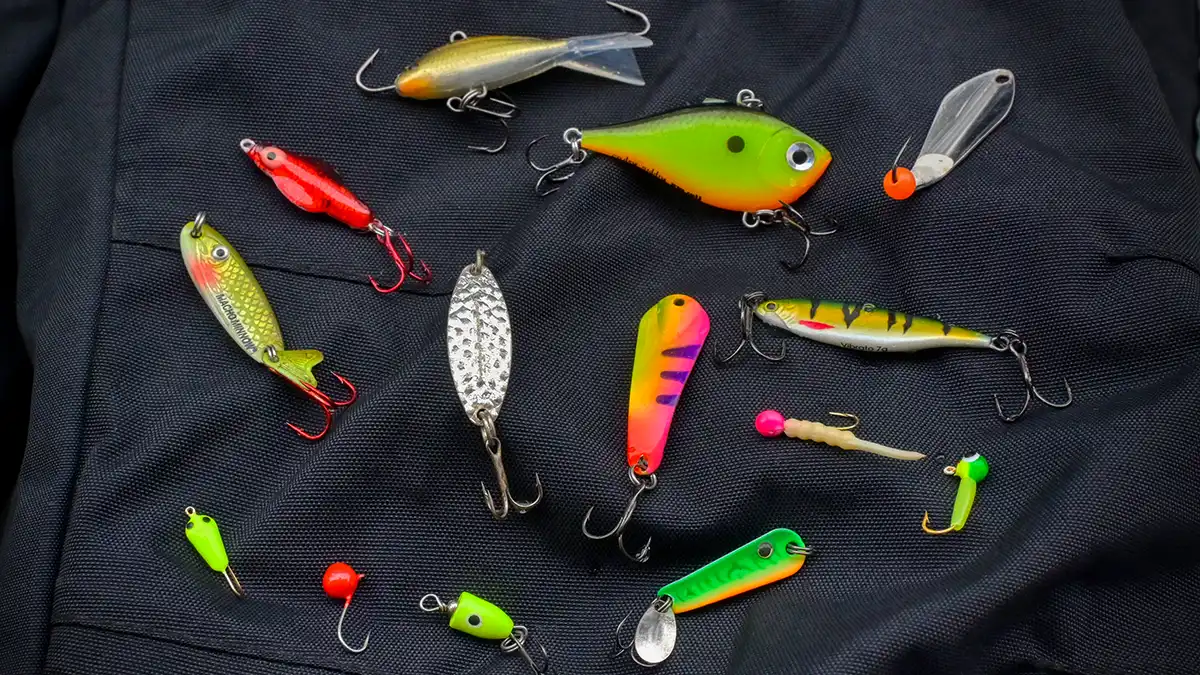
Lures, Jigs and Terminal Tackle for Ice Fishing
You don’t need a huge pile of baits when getting started as an ice angler, but some variety is good. A mix of different jigs and lures gives you options for experimenting with various presentations to learn what fish prefer on a given day. Here are some of the best baits to add to your ice fishing gear the next time you’re buying new tackle.
Jigging spoons
Spoons are essential. Their flashing, tumbling action mimics a wounded baitfish and they are a tried-and-true presentation from first to late ice. Have an assortment of straight to curved models, and rattling and non-rattling versions. Beaded spoons and spoons with dropper chains are also valuable.
Some options include: Berkley Vibrato, Clam Pinhead Pro, Custom Jigs and Spins Slender Spoon, Freedom Minnow Spoon, Lindy Rattlin’ Flyer, Luhr-Jensen Cast Champ, McGathys’ Slab Grabbers, Northland Buck-Shot Rattle Spoon, PK Predator, VMC Bull Spoon, and Williams Ice Jig.
Vertical Jigging Minnows
Also known as gliding jigs, lures like the Rapala Jigging Rap have a horizontal, lifelike minnow profile and a gliding swim few fish can resist. The ACME Hyper Glide, Clam Tikka Minnow, Moonshine Shiver Minnow, Rapala Jigging Shad Rap and Jigging Slab Rap, and Northland Puppet Minnow are other examples. These baits get down quick and are great for both attracting and triggering fish.
More Horizontal Lures
Lipless crankbaits and darters are worth having and can really rile-up strikes at times. Lipless cranks have really become hot on the ice fishing scene. You can learn about the evolution of lipless cranks in ice fishing here.
Examples of baits from these three categories include the 13 Fishing Micro Magic Man, Live-Target Golden Shiner Rattlebait, Jackall TN60, Rapala Rippin’ Rap, Salmo Chubby Darter and Yo-Zuri Rattl’n Vibe.
Finally, blade baits are sometimes overlooked, but are another potent ice presentation.
Jigs Paired with Plastics or Live-Bait
There are many jigs suitable for ice fishing. When you need to get down quickly to a school of fussy panfish, a tungsten tipped with a finesse plastic or a few maggots is a reliable choice. Walleye and whitefish anglers also use tungsten jigs when downsizing with artificial lures or live bait.
Lead jigs in vertical, horizontal and 45-degree profile are also essentials. Tipped with live-bait or outfitted with a plastic they catch all types of fish.
Speaking of soft-baits, there’s abundant choice for ice fishing. There are wispy worms with finesse tails, crayfish and other invertebrate imposters for panfish. Tubes and minnows catch everything from bluegills to big northern pike. Scented soft-baits in various shapes and sizes for tipping presentations can be the secret for turning lookers into biters when not using live-bait.
Berkley, Custom Jigs and Spins, LunkerHunt, Maki, Northland, VMC and Z-Man are just a few brands offering soft-plastics for ice fishing.
Tip: Generally, baits 1.5 inches or less are good for panfish and small trout, 1.5 to 2.5 inches for walleye and other mid-sized fish, and 3 inches and up for predators. Although, upsizing and downsizing are both strategies to employ when troubleshooting how to catch more or bigger fish.
Terminal tackle
Hooks, dropper chains, sinkers, swivels and snaps are important to carry. Specifics will depend on tactics used and target species.
Ice Fishing Storage
Storage containers in various sizes are useful for organizing and protecting ice fishing gear and equipment. Don’t skimp on this. Winter is hard on gear.
Flambeau, Gruv, Plano, Rapala and Rose Creek all make good pocket-sized tackle boxes. Rod cases come in many varieties and are essential for storing and transporting jigging set-ups. Currently, a Striker Transporter holds my fishing equipment, spare gloves, lunch and other items most days. I also rely on Otter and Frabill hard-plastic rod cases.
It’s not fancy, but a 5-gallon bucket is an inexpensive option for holding an ice skimmer, tip-ups and other items. A clip-on bucket seat adds even more functionality.
Learn more ice fishing gear storage tips here.
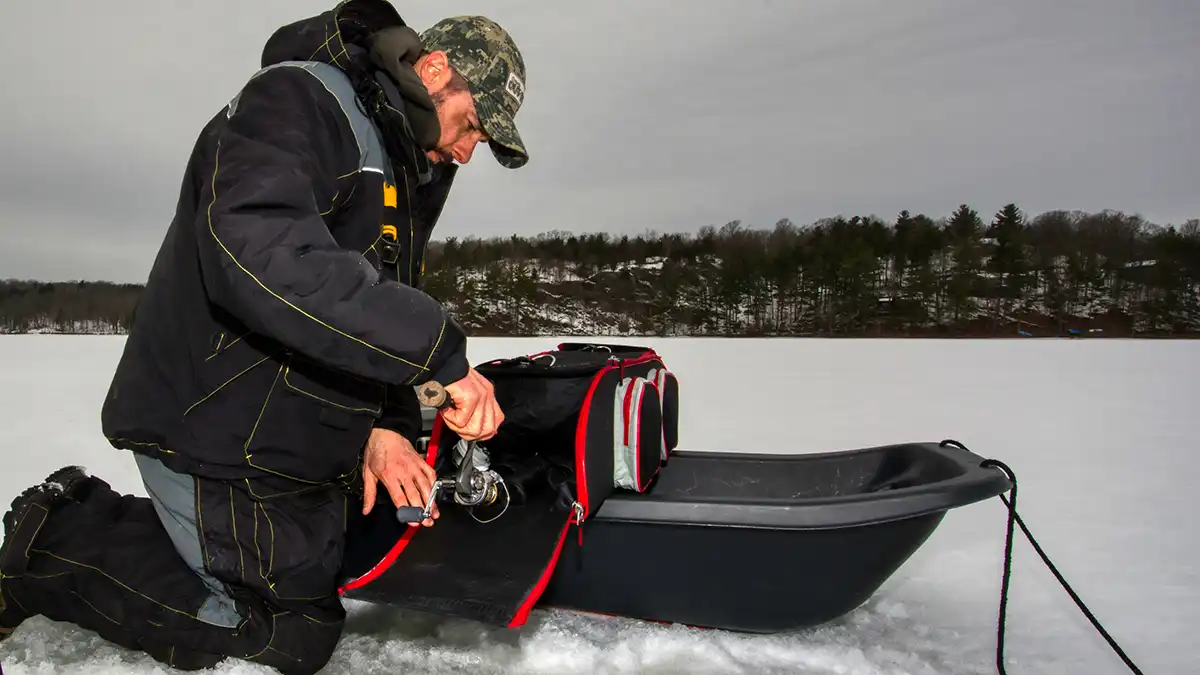
Ice Sleds
A rugged ice sled is a worthwhile investment for transporting gear. Options range from models anglers can pull on foot to heavy-duty sleds for towing behind snowmobiles and ATVs.
Choose a sled with high sides and a raised back. It will do a better job holding your gear and be more stable. Runners will help a sled track better and also reduce wear and tear on its base. Clam, Otter, Pelican and Shappell all make quality ice fishing sleds.
Portable Fish Houses (aka Ice Fishing Shelters)
Flip-Over Ice Fishing Shelters
Flip-and-go portable ice fishing shelters take the sled concept one step further, offering the additional benefit of having a flip-over enclosure built into their design. When you want to block the wind, trap heat and get comfortable on a spot, simply grab a seat and flip up the shelter. These shelters are ideal for run-and-gun fishing.
Clam, Eskimo, Frabill, and Otter all make ice shelters. Learn more about ice shelters in this video.
Tip: A sled cover is useful for preventing items from falling out during travel, and keeps snow and slush from getting in.
Hub Shelters
These pop-up shelters are the other major type of portable fish houses. Hub-style shelters don’t have a sled base, but rather are akin to a rugged camping tent. The latest models are fast to set up as well as take down, and come in shapes to maximize fishing space and headroom. Hub style ice houses are great for big groups and setting up a base camp location.
Fish house comfortability increases with the addition of a portable propane heater. My friends and I have good success using Mr. Heater’s products, which offer an automatic low oxygen depletion sensor and an accidental tip-over safety shut-off. This said, having a battery-powered carbon monoxide detector inside the shelter is an added safety measure.
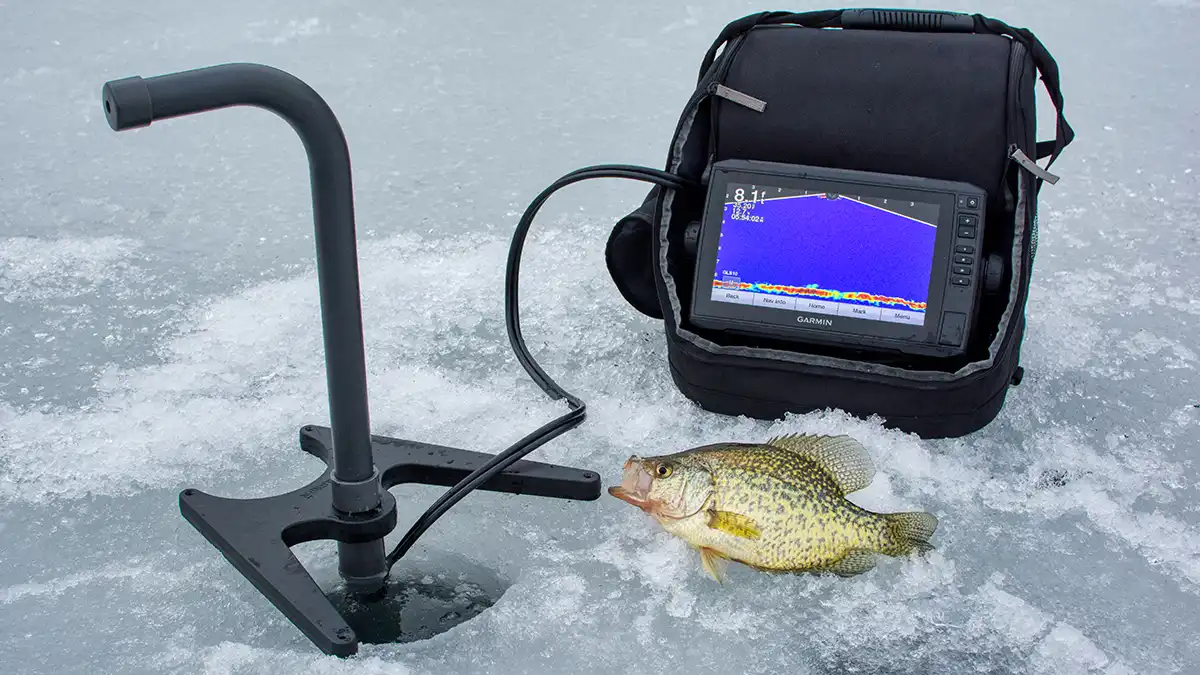
Fish Finders and Underwater Cameras
A common question is do you need a portable fish finder for ice fishing? For many ice anglers the answer is a resounding “Yes!”. The reason why is a portable fish finder makes you a more efficient angler. We consider it absolutely necessary ice fishing gear if you plan to fish a lot in the winter.
An entry-level model provides the essential tech you need for ice fishing. Specifically, a 2D sonar showing bottom depth, plus the movements of your lure and fish moving through the water column as detected within the transducer’s beam.
The next tier of fish finders add GPS functionality and likely include base maps of lakes. These features help find productive fishing locations.
The most cutting-edge portable fish finders go further, allowing anglers to easily scan a 100 foot perimeter from the transducer’s location within the ice hole. Garmin’s LiveScope Plus Ice Fishing Bundle LI or Humminbird’s Mega 360 Ice and Mega Live Ice are examples.
Tip: Products are available for making your own portable ice fishing sonar pack, which is worth considering if you’ve already invested in quality electronics for your fishing boat or kayak.
While arguably not an essential for beginners, a compact underwater camera, such as one of Aqua-Vu’s Micro products, is handy to have for identifying fish. This helps avoid unknowingly fishing the wrong species, such as jigging a hump loaded with smallmouth or catfish when you’re looking for walleye. Underwater cameras deliver the best picture in clear water, but don’t let this discourage you from using one in other conditions. As professional guide Brian Brosdahl once told to me, “I don’t need a picture of the whole fish to know what type it is, I just need to see faces or tails.”
Many ice fishing electronics come with a sealed lead acid (SLA) battery, but a lot of ice anglers are switching to lithium. Compared to a SLA with similar specs, a lithium battery delivers significantly more runtime. Lithium batteries are more expensive, but they have a longer lifespan than SLAs, which makes the higher upfront cost likely to balance out over the long run.
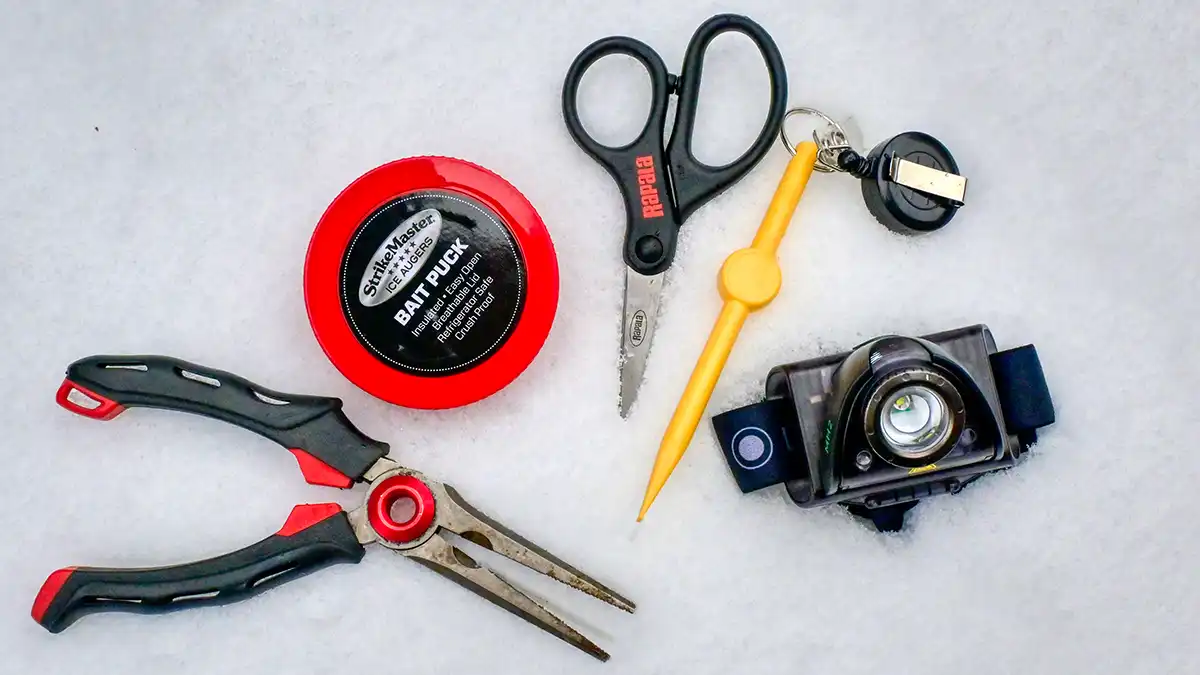
Tools and Other Handy Items
You’ll need a variety of fishing tools and other gear to be fully kitted-out for ice fishing. Here are some other things to carry.
Hook removal tools, including pliers and jaw spreaders, as well as hemostats or a product like the Cold Snap Pro Team Tungsten Toothpick for removing small jigs from panfish
- Split ring pliers
- Scissors and line cutters
- Hook file
- Clip on depth finder
- Rod holders
- Minnow bucket with a dip net
- Smaller bait container for maggots, wax worms, etc.
- Fish towel (wet hands = cold hands)
- Light sources (headlamp, flashlight, lantern)
- Compact / folding shovel
- Travel chair
Troubleshooting/repair kit containing basic tools, materials, like duct tape and zip ties, along with spares of critical items (e.g., auger blades and spark plug, batteries, etc.).
Safety Gear
Ice safety tips and equipment are discussed at length in the Best Ice Fishing Tips to Get Started article, so we won’t repeat details here. But, here’s a recap of some ice safety essentials: spud bar (ice chisel), ice claws/picks, throw rope, whistle, first aid kit, boot cleats, extra food and water, fire starter, and a change of clothes.
Learn more about ice safety in this video.
As you can see, there’s no shortage of ice fishing equipment available. We hope this review of essential hard-water gear helps you choose the best products you need to get started catching fish this winter, but also gives you an appreciation of the other items you’re likely to need and want as you become a more skilled and committed ice angler.
